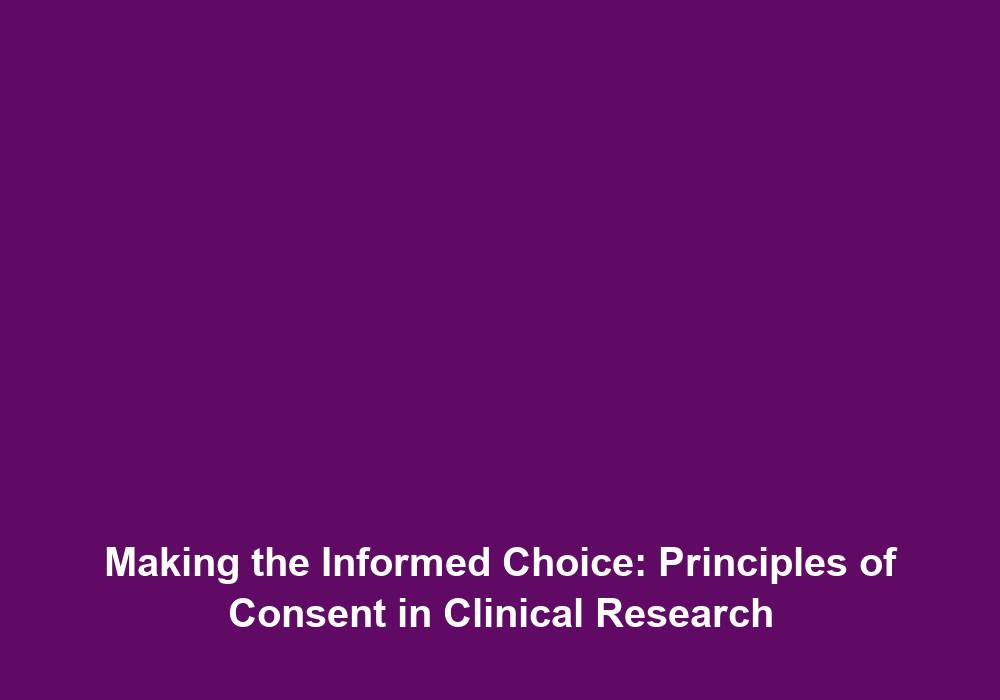Making the Informed Choice: Principles of Consent in Clinical Research
Clinical research plays a crucial role in advancing medical knowledge and finding new treatments and interventions for various health conditions. However, conducting research involving human participants requires adherence to ethical principles, particularly when it comes to obtaining informed consent. In this article, we will delve into the principles of consent in clinical research, exploring its importance, key components, and the process involved.
Understanding Consent in Clinical Research
Consent, in the context of clinical research, refers to the voluntary agreement of an individual to participate in a study after being provided with comprehensive and understandable information about the research project. Obtaining informed consent is fundamental to respect and protect the rights and well-being of research participants.
Informed consent is essential in clinical research as it upholds the principle of autonomy. Autonomy recognizes an individual’s right to make decisions regarding their own body and health. By obtaining informed consent, researchers honor the autonomy of potential participants and empower them to make an informed choice about their involvement in the study.
Furthermore, informed consent is crucial for the protection of participants. It ensures that individuals are fully aware of the potential risks, benefits, and alternatives associated with participation in a research study. This knowledge allows participants to weigh the potential benefits against the potential risks and make an informed decision that aligns with their best interests.
In addition to respecting autonomy and protecting participants, obtaining informed consent is an ethical responsibility for researchers. They must ensure that participants are adequately informed about the research process, procedures, and any potential risks involved. Failure to obtain informed consent not only violates ethical standards but can also jeopardize the integrity and validity of the study.
Key Components of Informed Consent
To ensure the informed consent process is comprehensive and transparent, the following key components should be included:
- Information Disclosure: Researchers must provide potential participants with clear, concise, and understandable information regarding the purpose, procedures, risks, benefits, and anticipated outcomes of the research study. This information should be presented in a language and format that is accessible to the participant.
In order for participants to make an informed decision, it is crucial that they have all the necessary information about the research study. Researchers should disclose information about the purpose of the study, the specific procedures involved, potential risks and benefits, and the anticipated outcomes. It is important to present this information in a language and format that is easily understandable to the participant, avoiding technical jargon or complex terminology.
- Voluntary Participation: It is crucial that participants understand their participation in the study is entirely voluntary. They should be aware that they have the right to withdraw from the study at any time without facing any negative consequences or penalties.
Participants should be explicitly informed that their participation in the study is voluntary and that they have the right to withdraw at any time. They should be assured that their decision to withdraw will not result in any negative consequences or penalties. This ensures that participants feel empowered to make a decision that is in their best interest without feeling coerced or obligated to continue participating.
- Comprehension: Researchers should assess the participants’ understanding of the provided information and address any questions or concerns they may have. This can be done through interactive discussions, clarification sessions, or educational materials tailored to the participant’s level of comprehension.
It is crucial to ensure that participants fully understand the information provided to them. Researchers should encourage participants to ask questions and seek clarification about any aspect of the research study. This can be achieved through interactive discussions, clarification sessions, or the provision of educational materials that are tailored to the participant’s level of comprehension. Addressing questions and concerns helps ensure that participants have a complete understanding of the study, its potential implications, and any associated risks.
- Capacity for Consent: Researchers must ensure that potential participants possess the mental capacity and ability to make an informed decision. This requires assessing their cognitive abilities and determining if they are capable of understanding the information provided and the implications of their participation.
Before obtaining informed consent, researchers should assess the cognitive abilities of potential participants. It is important to determine if individuals have the mental capacity to understand the information provided and the implications of their participation. This assessment helps ensure that participants are capable of making an informed decision and protects individuals who may not have the capacity to fully comprehend the research study.
- Documentation: Informed consent should be documented through a written consent form signed by the participant or their legally authorized representative. This form serves as evidence that the participant has voluntarily agreed to participate after understanding the information provided.
To ensure accountability and transparency, informed consent should be documented through a written consent form. This form should include all relevant information about the study, the participant’s agreement to participate, and any additional details that may be required by regulatory bodies or ethical committees. The signed consent form serves as evidence that the participant has voluntarily agreed to participate after understanding the information provided.
The Consent Process
The consent process typically involves the following steps:
- Initial Contact: Potential participants are approached and provided with an overview of the research study. This initial contact should be conducted in a manner that ensures privacy and allows individuals time to consider their potential participation.
During the initial contact, researchers provide potential participants with an overview of the research study. It is important to approach individuals in a respectful and private manner, allowing them sufficient time to consider their potential participation. This ensures that individuals are not pressured or rushed into making a decision.
- Information Provision: Once potential participants express their interest, researchers provide them with detailed information about the study, including its purpose, procedures, potential risks, benefits, and alternatives. This information should be conveyed in a language and format that is easily understandable to the participant.
After expressing interest, potential participants should be provided with detailed information about the research study. Researchers should explain the purpose of the study, the specific procedures involved, potential risks and benefits, and any available alternatives. It is important to convey this information in a language and format that is easily understandable to the participant, using clear and concise language without overwhelming them with technical details.
- Question and Answer Session: Researchers should encourage potential participants to ask questions and seek clarification about any aspect of the research study. This session allows participants to gain a deeper understanding of the study and address any concerns they may have.
To ensure that participants have a clear understanding of the research study, researchers should actively encourage them to ask questions and seek clarification. This question and answer session provides participants with an opportunity to gain a deeper understanding of the study and address any concerns or doubts they may have. It is important for researchers to provide honest and accurate responses to ensure transparency and build trust with participants.
- Assessment of Understanding: Researchers should assess the participant’s understanding of the provided information by asking open-ended questions or using validated assessment tools. This step ensures that participants comprehend the research study, its potential implications, and any associated risks.
To gauge the participant’s understanding of the provided information, researchers should assess their comprehension. This can be done through open-ended questions or the use of validated assessment tools. By assessing understanding, researchers can ensure that participants have a clear comprehension of the research study, its potential implications, and any associated risks. This step is crucial in verifying that participants are making informed decisions.
- Decision-making: Once participants have received the necessary information and their questions have been addressed, they are given sufficient time to consider whether they want to participate in the study. This decision should be made voluntarily, without coercion or undue influence.
After receiving all the necessary information and having their questions answered, participants should be given sufficient time to consider their decision. It is important that the decision to participate is voluntary and not influenced by coercion or external pressures. Participants should be empowered to make a decision based on their own judgment and best interests.
- Consent Documentation: If participants decide to participate, they are asked to provide written consent by signing a consent form. This form should be comprehensive, clearly stating the purpose of the study, procedures involved, potential risks and benefits, confidentiality measures, and the right to withdraw at any time.
If participants choose to participate in the study, they are asked to provide their consent by signing a written consent form. The consent form should be comprehensive and clearly outline the purpose of the study, specific procedures involved, potential risks and benefits, confidentiality measures, and the participant’s right to withdraw from the study at any time. It is important for the consent form to be detailed and easily understandable to ensure that participants are fully informed before providing their consent.
Ensuring Consent in Vulnerable Populations
When working with vulnerable populations, such as children, individuals with cognitive impairments, or those with limited comprehension abilities, additional measures are necessary to protect their rights and ensure informed consent:
- Proxy Consent: In cases where individuals lack the capacity to provide informed consent, a legally authorized representative, such as a parent or guardian, may provide proxy consent on their behalf. However, efforts should be made to obtain assent or agreement from the individual, whenever possible.
In situations where individuals lack the capacity to provide informed consent, a legally authorized representative, such as a parent or guardian, may provide proxy consent on their behalf. However, it is important to make efforts to obtain assent or agreement from the individual whenever possible. This ensures that the individual’s voice is heard and their preferences are taken into consideration.
- Simplified Language: Information provided to individuals with limited comprehension abilities should be presented in simplified language, using visual aids or audio recordings to enhance understanding. The use of interpreters or translators may also be necessary when language barriers exist.
When working with individuals who have limited comprehension abilities, it is important to present information in a manner that is easily understandable. This can be achieved by using simplified language, visual aids, or audio recordings to enhance comprehension. In cases where there are language barriers, the use of interpreters or translators may be necessary to ensure effective communication.
- Independent Advocacy: In certain situations, an independent advocate or guardian may be appointed to represent the interests of the participant, ensuring their rights are protected throughout the research process.
To safeguard the rights of vulnerable individuals, an independent advocate or guardian may be appointed to represent their interests throughout the research process. This independent advocate ensures that the rights of the participant are protected and that their well-being is prioritized. The advocate acts as a support system and ensures that the participant’s voice is heard and their rights are upheld.
In conclusion, the principles of consent in clinical research are vital for upholding ethical standards and safeguarding the rights and well-being of research participants. By ensuring a comprehensive informed consent process that includes information disclosure, voluntary participation, comprehension assessment, and proper documentation, researchers can make the consent process transparent and respectful. Additionally, when working with vulnerable populations, additional measures must be in place to protect their rights and ensure their meaningful participation in research studies.






